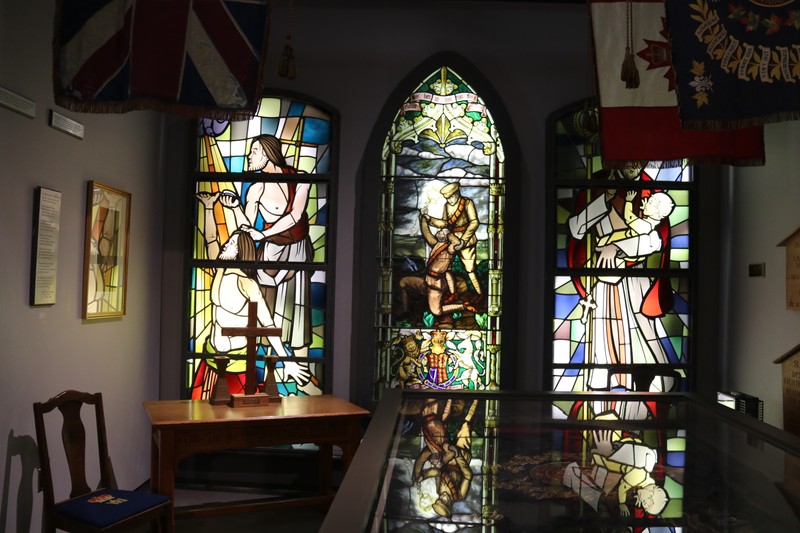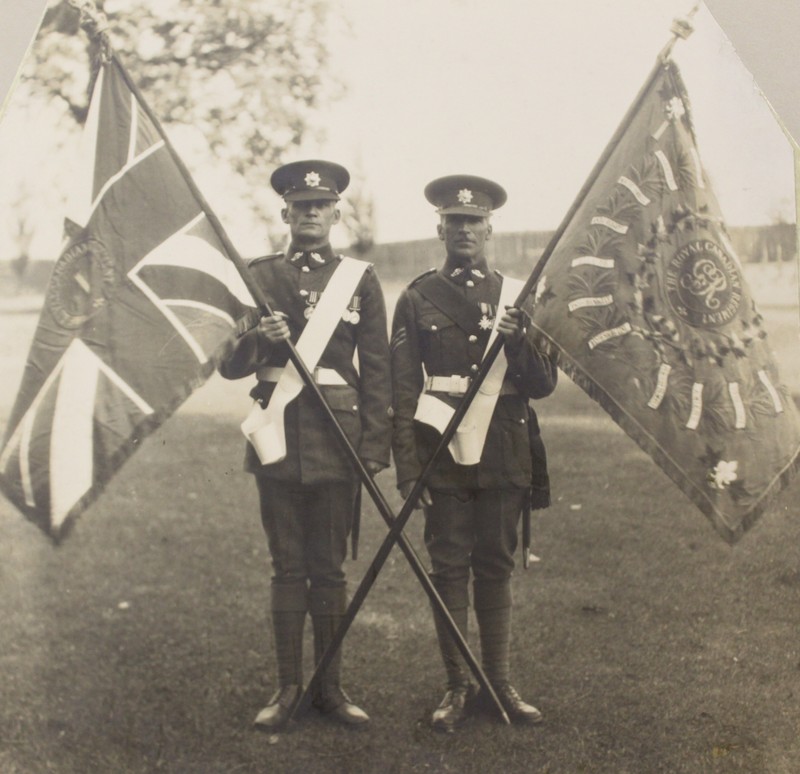Quiet Room
Introduction
Text-to-speech Audio
Images
Stained glass windows

Colours
.jpg)
Regimental Colours presented by King George V, 26 May, 1932

The Modern Samaritan
.jpg)
Memorial plaques within the Quiet Room
.jpg)
Backstory and Context
Text-to-speech Audio
The Quiet Room was previously a museum chapel complete with rows of pews, but it is now used to display colours, and as a place to remember the sacrifices of those in The RCR. The room holds a number of artifacts that are of great significance to the regiment.
Regimental Colours
A set of colours for a battalion of The Royal Canadian Regiment (RCR) consists of: a Queen’s (or King's) Colour, signifying loyalty to the Crown; and a Regimental Colour, signifying loyalty to the regiment. Colours are prized possessions for a unit and they symbolize honour, tradition, and devotion to sovereign and country. In the past, colours marked a unit's place on the battlefield and provided a rallying point, but in modern times they are largely used during formal ceremonies.
The Queen's Colours were previously based on the Union Jack. Since the adoption of the Maple Leaf Flag in 1965, they have resembled Canada's national flag. In the centre of the maple leaf is a circle surmounted by a crown with the name of the regiment and a roman numeral denoting the battalion that they belong to. They have a gold and crimson fringe.
Regimental Colours are blue with a gold and blue fringe. In the centre is a royal cypher representing the sitting monarch. Around the cypher are scrolls that list a regiment’s battle honours. Recently, Afghanistan has been approved as a battle honour. The regimental colour will be redesigned to accommodate it.
In the center of the room is the oldest set of colours for The RCR. The regiment received them in 1901, they feature four scrolls indicating South Africa, Paardeburg, Saskatchewan, and North West Canada. The space also features colours presented after the First World War, which add 10 additional battle honours, as well as a set from after the Korean War with 11 more battle honors from the Second World War and Korea.
Stained Glass
The stained glass is another major feature of this space. There are three panels in this gallery. The two on the sides were designed by a member of The RCR and are from a chapel in Soest, Germany. They were brought back to Canada after the regiment left the area. The center piece is from the Bethesda Church in nearby Thorndale, Ontario. The church was set to be demolished when the stained-glass panel was brought to the museum. It commemorated Pte. Fitzgerald of the Princess Patricia’s Canadian Light Infantry (PPCLI) who was killed in May 1916. The PPCLI was founded in 1914 and today is one of the three regular force infantry regiments in Canada.
Modern Samaritan
The Modern Samaritan was painted by Edward R. Glen in 1918. Edward Glen (1887-1963) was born in London, Ontario. The painting depicts a Canadian soldier giving water to an injured German soldier.
Sources
Brumwell , Miranda. 1RCR unveils Battalion Colours mural , Canadian Military Family Magazine . June 15th 2018. Accessed July 20th 2020. https://www.cmfmag.ca/history/1-rcr-unveils-battalion-colours-mural/.
Fitzgerald, James (First World War Personnel Record), Library and Archives Canada . Accessed July 20th 2020. https://www.bac-lac.gc.ca/eng/discover/military-heritage/first-world-war/personnel-records/Pages/item.aspx?IdNumber=391426.
Government of Canada . Gallery of Canadian Forces guidons, colours and standards, November 15th 2019. Accessed July 20th 2020. https://www.canada.ca/en/services/defence/caf/military-identity-system/guidons-colours-standards-gallery/gallery-guidons-colours-standards-army.html.
Government of Canada . Heritage Structure | Annex A - The design of standards, guidons and colours, November 13th 2019. Accessed July 20th 2020. https://www.canada.ca/en/services/defence/caf/military-identity-system/heritage-manual/chapter-5/annex-a.html.
Regimental Executive Committee. Regimental Standing Orders - The Royal Canadian Regiment . Petawawa, Ontario. Regimental Headquarters, 2017. http://thercr.ca/CMFiles/2017_Regimental-Standing_Orders.pdf
Royal Canadian Regiment, The. Regimental Catachism. 2017. http://www.thercr.ca/CMFiles/The_RCR_Catechism_2017.pdf
The RCR Museum Photograph
The RCR Museum Photograph
The RCR Museum Collection
The RCR Museum Photograph
The RCR Museum Photograph
